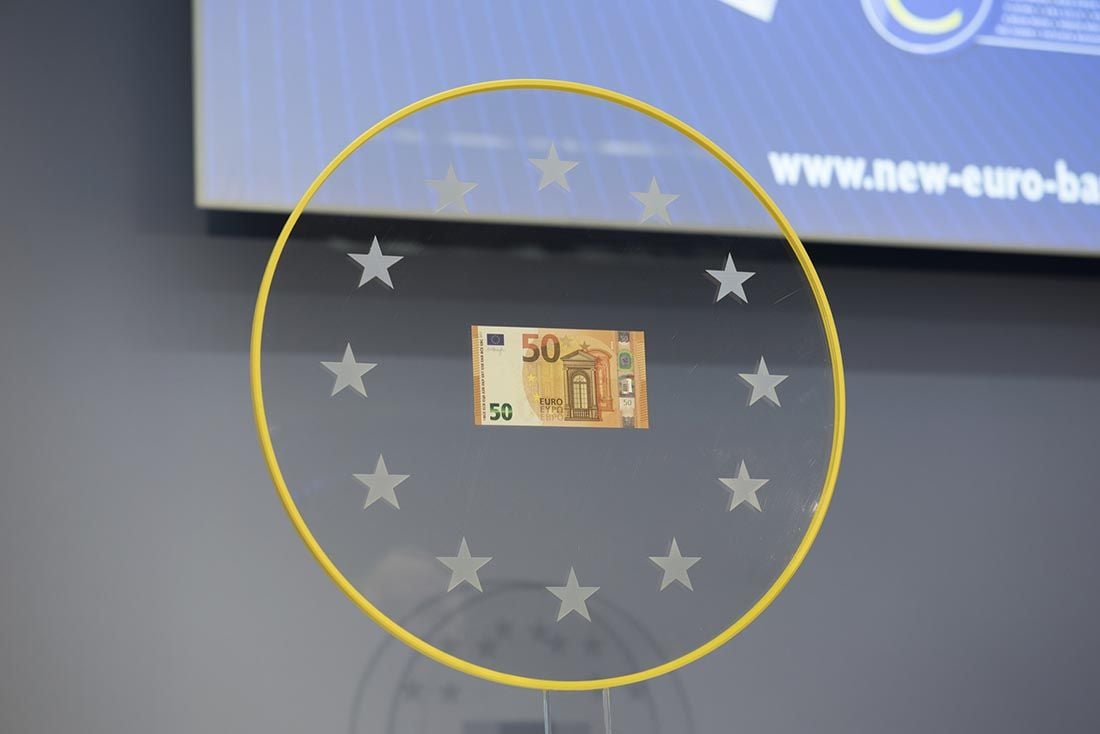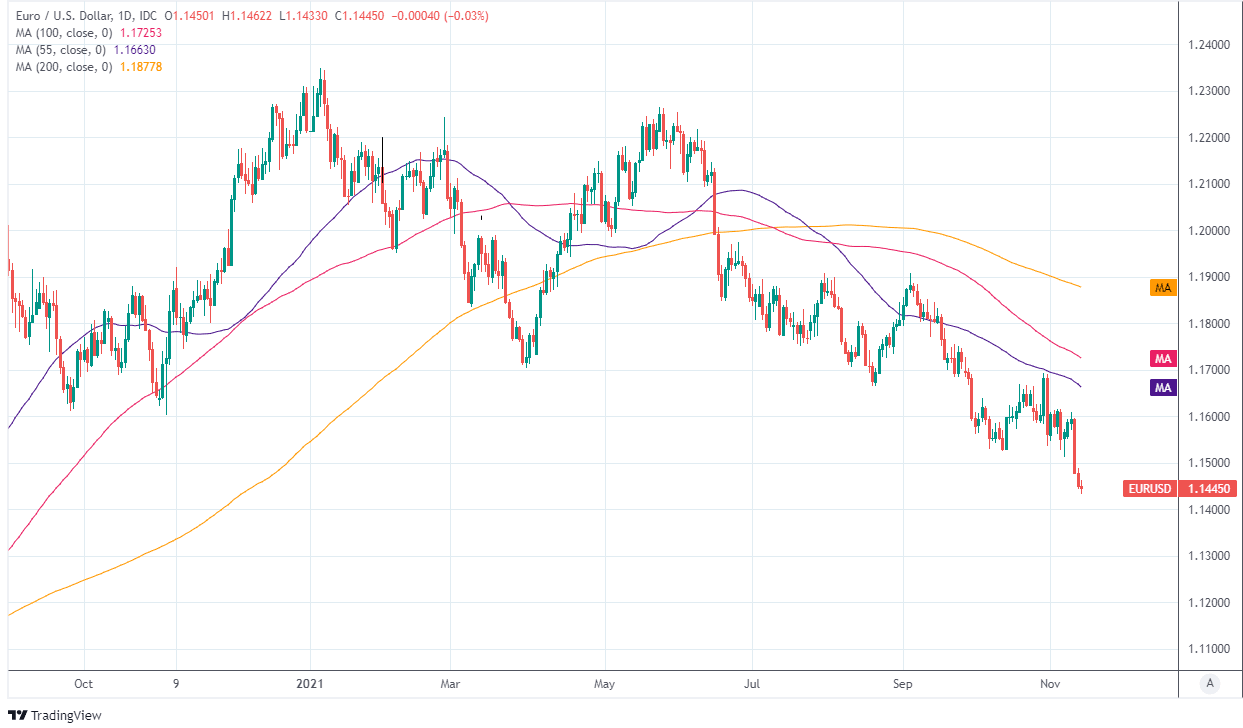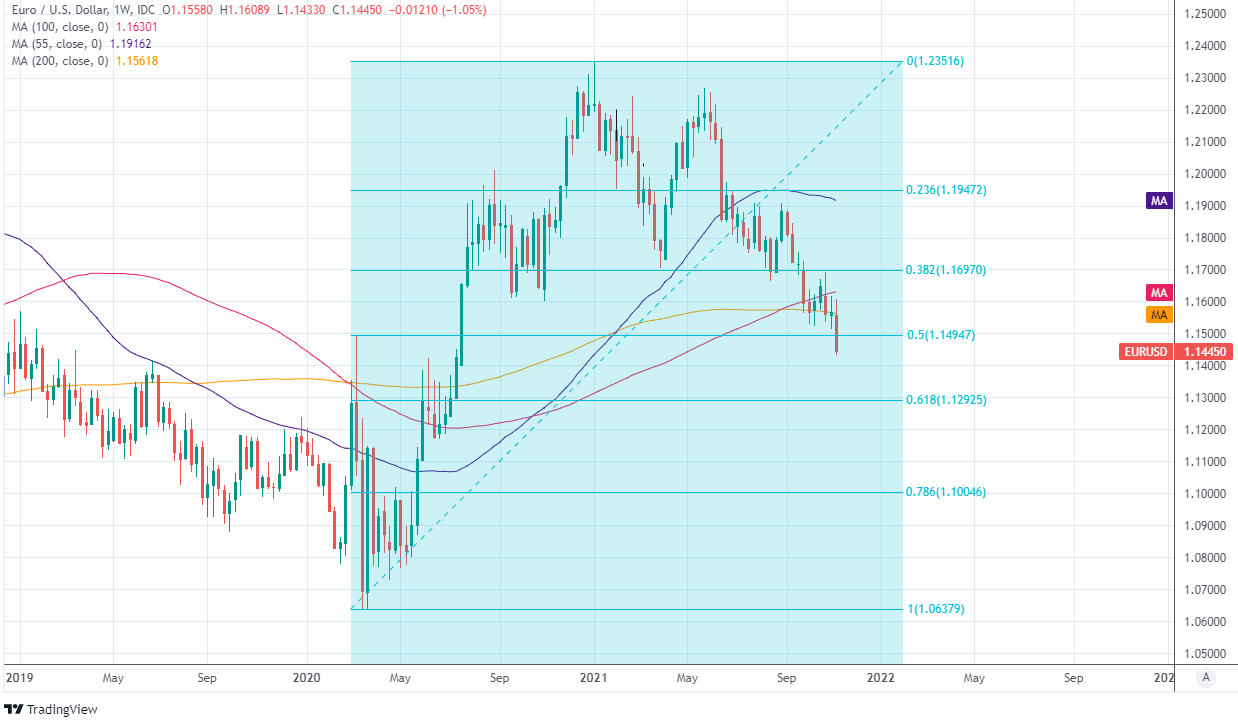Euro / Dollar Week Ahead Forecast: Supported Near 1.1425 but Downside Risks Abound
- Written by: James Skinner
EUR/USD thinly supported at 1.1425 and vulnerable
After USD rally undermines major support on charts
As EZ economies edge toward new virus restrictions
Fed chatter, USD, EZ GDP and ECB speech in focus

Image © European Central Bank
The Euro to Dollar rate sustained its largest decline since late September last week, breaking a major technical support level while placing another near 1.1425 under pressure along the way, although multiple analysts have warned that downside risks continue to abound for the single currency.
Europe’s unified unit was one of the few major currencies to sit out a corrective fall in U.S. exchange rates in the final session of last week when it clocked up a fractional decline against the greenback in what may have been a response to the latest coronavirus developments on the continent.
“Peripheral EU FX is feeling the squeeze on this, from the Swedish krona to the CEE currencies, some of which are reaching cycle lows versus the single currency,” says John Hardy, head of FX strategy at Saxo Bank, in a Friday research note.
“We have hardly suffered much of a setback in risk recently, but the focus on growth concerns in Europe on the natural gas debacle and perhaps now even on Covid, as the SEK in the firing line, given its often that it often is seen as a high-beta proxy to EU economic strength,” Hardy also said.
Signs of a continental return toward the containment measures of the past place one more question mark over the Eurozone economic outlook for the winter months and just as the Dollar benefits from increasing investor conviction that the Federal Reserve could be likely to lift its interest rate in the latter half of next year, which weighed heavily on the Euro-Dollar rate previously last week.
Above: Euro-Dollar rate shown at daily intervals with selected moving-averages indicating possible areas of resistance.
- EUR/USD reference rates at publication:
Spot: 1.1455 - High street bank rates (indicative band): 1.1057-1.1137
- Payment specialist rates (indicative band): 1.1355-1.1400
- Find out about specialist rates, here
- Or, set up an exchange rate alert, here
“We have a support line, which connects a number of lows since July, and this comes in at 1.1424 today. There is scope for support on the previous downtrend (from 2008) which is now located at 1.1366 and should act as strong support. We look for this to hold,” says Karen Jones, head of technical analysis for currencies, commodities and bonds at Commerzbank.
Jones and the Commerzbank technical analysis team had been sellers of the Euro-Dollar rate from 1.1590 but exited the position on Friday having tipped clients that they expect the downtrend in the exchange rate to ebb around the nearby 1.1366 area over the coming weeks and months.
They have however, warned that the single currency may be likely to remain under pressure while the market remains below the 1.1655 area, which coincides with a downward-sloping trendline drawn from May highs above 1.22 and running down to early October highs near 1.17, while others have warned that a deeper setback could be likely for the Euro in the days and weeks ahead.
“The EUR is steadying in the mid-1.14s but remains prone to more fundamentally driven weakness in the near- and medium-term,” says Juan Manuel Herrera, a strategist at Scotiabank, in a Friday research note.
{wbamp-hide start}
{wbamp-hide end}{wbamp-show start}{wbamp-show end}
“The EUR has lost significant support points in the past few weeks and trend dynamics across the short, medium and longer-term DMI oscillators are aligned bearishly for the EUR, which typically implies little or no scope for counter-trend corrections and ongoing downside pressure on the market. We continue to target 1.14 as the near-term bear objective. The 1.10/1.11 zone remains very viable in the next few months,” Herrera also said.
While the market may be likely to remain attentive to the coronavirus situation on the continent, other factors will also matter too for price action in the Euro-Dollar rate including the initial estimate of third-quarter GDP growth from Eurostat on Tuesday.
Consensus expects GDP to reveal a strong 2% quarter-on-quarter growth rate for the latest quarter although.
This is followed by opening remarks from President Christine Lagarde at the Frankfurt European Banking Congress around 08:00 on Friday.
Most significant for the single currency could be the cut of investor appetites for the Dollar after U.S. October inflation was reported as in excess of 6% last week.
This prompted a scramble in financial markets to fully price-in a 0.25% increase in the Federal Funds rate range for each of the third and final quarters of 2022 and then some for 2023.
“The sharp acceleration in US CPI inflation in October drove US yields higher and widened the corresponding UST-Bund spread, forcing EUR-USD to break through the key 1.15 baseline,” says Roberto Mialich, an FX strategist at UniCredit Bank.
Above: Euro-Dollar rate shown at weekly intervals with selected moving-averages indicating possible areas of resistance and Fibonacci retracements of 2020 recovery highlighting potential areas of technical support.
Secure a retail exchange rate that is between 3-5% stronger than offered by leading banks, learn more.
The Euro is among the most vulnerable of the major currencies to Federal Reserve rate rises in part because markets perceive the European Central Bank (ECB) as being likely to trail behind the Fed and other central banks when eventually normalising its monetary policies, which is a part of why the Euro-Dollar rate could also be sensitive to what are no less than 15 speaking engagements scheduled for seven Fed policymakers this week.
“After breaking below 1.1500, we think the market sentiment on EUR/USD is skewed towards the downside, both from a technical perspective and from a fundamental one given the widening USD-EUR rate differential,” says Chris Turner, global head of markets and regional head of research for UK & CEE at ING.
“The pair remains slightly overvalued (by 0.50%) according to our short-term fair value model: this is because the main driver of EUR/USD fair value (the short-term rate differential) has widened significantly, “justifying” a good share of the EUR/USD drop. We think we could see EUR/USD extend losses to the 1.1300 level in November, before some USD-negative seasonality comes to the rescue in December,” Turner also said.
While the market has scrambled to price-in an increase in the U.S. Fed Funds rate range from between 0% and 0.25% in 2021 to between 0.5% and 0.75% for 2022, there is still scope for wagers about U.S. interest rates to grow in relation to 2023 and 2024, which could keep upside risks alive for the greenback as well as the downside risks in place for the Euro-Dollar rate during the coming weeks and months.







